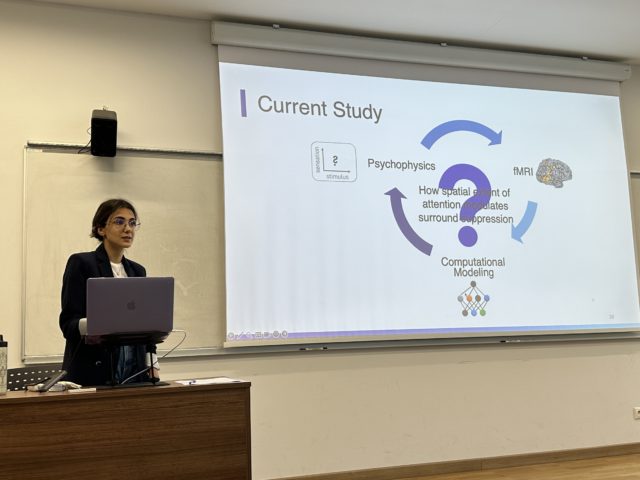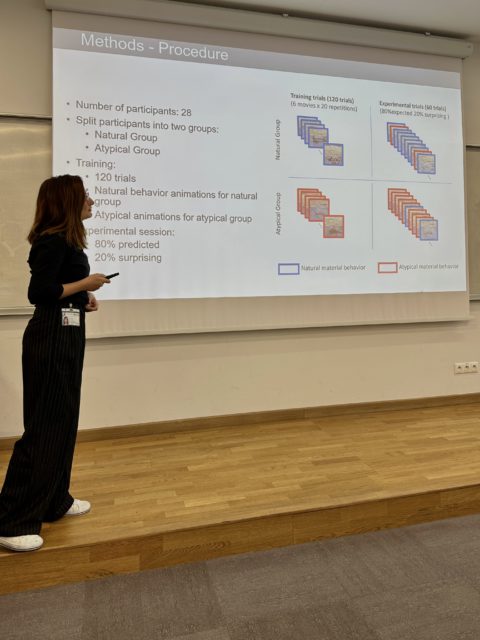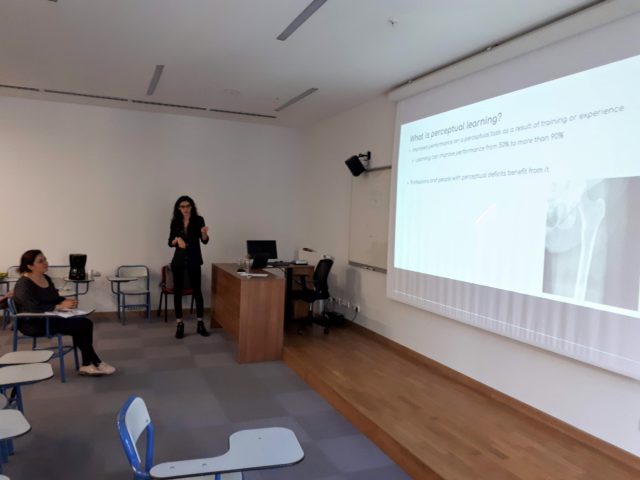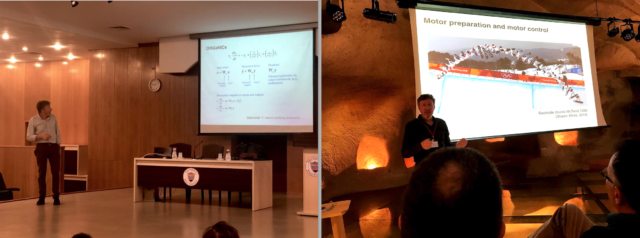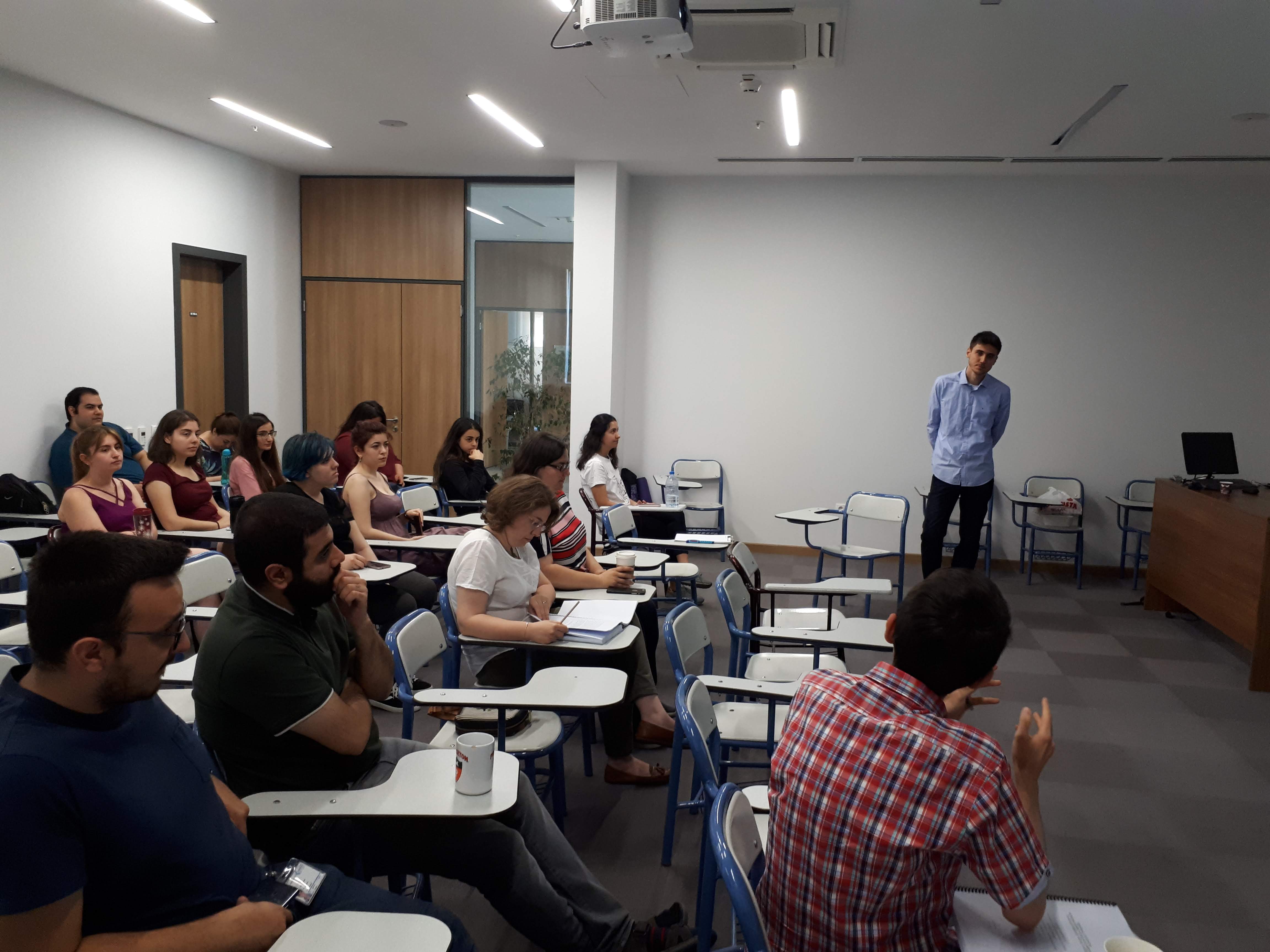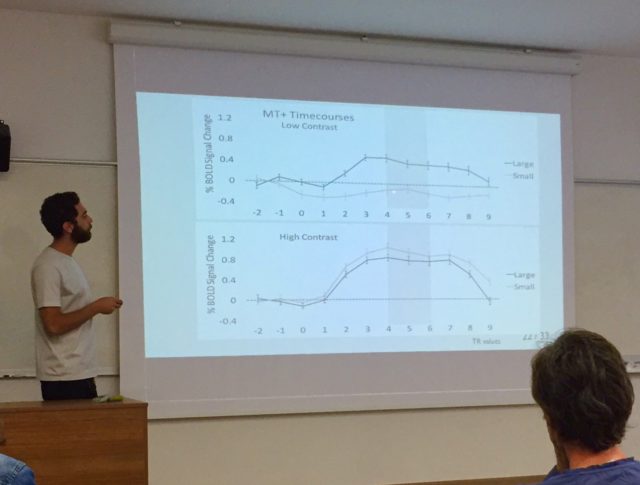The Computational and Biological Vision Group, led by Hüseyin Boyacı and Katja Doerschner, is part of Aysel Sabuncu Brain Research Center and National Magnetic Resonance Research Center (UMRAM) and operates jointly with the Departments of Psychology and Neuroscience, Bilkent University. We also have close relations with the Psychology Department at JL Giessen University. Research in the lab is focused on visual perception and its neuronal underpinnings. We use behavioral experimentation, neuroimaging (fMRI), and computational modeling to find answers to problems of vision science.
Here, you can find out more about our projects.
Recent News
Publication Updates
Pamir, Z., and Boyaci, H. (2025). “Visual appearance and sensitivity are mediated by distinct mechanisms,” is published in Neuropsychologia. https://doi.org/10.1016/j.neuropsychologia.2025.109277. (13/10/2025)
Elmas et al. (2025), “Predictive processing in biological motion perception: Evidence from human behavior,” is published in Perception. https://doi.org/10.1177/03010066251355391 (20/7/2025)
Our study with Ecem Altan, Steven C. Dakin D. Samuel Schwarzkopf, “Perceiving object size in pictures involves high-level processing,” is now published in Proceedings B: https://doi.org/10.1098/rspb.2024.2967 (14/5/2025)
Merve’s results are now published in the Journal of Vision: https://jov.arvojournals.org/article.aspx?articleid=2802913 (24/4/2025)
Amna’s study “Neural correlates of dynamic lightness induction” is published in the Journal of Vision. Results of Merve’s study “hMT+ Activity Predicts the Effect of Spatial Attention on Surround Suppression” are available on bioRxiv. (17/10/2024)
News from Alumni
This academic year, all CBVG alumni are on their way to Germany! Amna Malik and Merve Kiniklioglu (PhD) will continue their careers as post-docs at JLU Giessen. Büşra Ayar and Ecenur Bilgiç (BA) will continue their graduate studies at the University of Göttingen and LMU Munich, respectively. Congratulations, and good luck at their new positions. (11/10/2023)
Merve Kınıklıoğlu Successfully Defended Her PhD Thesis
Merve successfully defended her thesis titled “Behavioral and Neural Investigation on the Effect of Spatial Attention on Surround Suppression”. Congratulations Merve! (22/9/2023)
Amna Malik Successfully Defended Her PhD Thesis
Dr. Amna Malik has passed her Ph.D. dissertation exam with flying colors. Her thesis title is “Effects of Context and Expectations on Dynamics of Visual Processing”. Congratulations Amna! (12/9/2023)
New Preprint
, H (2023). Neural correlates of spatiotemporal properties of lightness induction. bioRxiv. https://www.biorxiv.org/content/10.1101/2023.07.28.550941v1. As the frequency of surround temporal modulation increases, the dynamic lightness induction reduces, but the border contrast energy increases. Our results show that the primary visual cortex (V1) fMRI activity follows lightness induction. In other words, the activity of V1 correlates with perceived lightness, not low-level contrast energy. (22/8/2023)
Two New Publications
Gurbuz, T, Boyaci, H (2023). Tilt aftereffect spreads across the visual field. Vision Research, 205. https://doi.org/10.1016/j.visres.2022.108174 (Also bioRxiv, https://doi.org/10.1101/2022.06.21.496978). In this study, we show that contrary to the assumptions in the literature, prolonged exposure to a stimulus at a certain location in the visual field may affect the perception of subsequently shown stimuli at other locations. In other words, visual adaptation may be a non-local phenomenon. We propose possible computational mechanisms and cortical areas that might be giving rise to this.
Malik, A, Doerschner, K, Boyaci, H (2023). Unmet expectations about material properties delay perceptual decisions. Vision Research, 208. https://doi.org/10.1016/j.visres.2023.108223 (Also bioRxiv https://www.biorxiv.org/content/10.1101/2022.07.28.501825). When an object behaves in an unexpected way, for example, if an object that looks like an iron stick starts wobbling, we get surprised. In this study, we show that such violations of expectations delay our perceptual decisions. Our results suggest that, unlike the common thinking in the literature, fulfilled expectations may not always facilitate perceptual processing; instead, unmet expectations may delay those processes. We suggest possible normative computational models underlying this effect. (26/4/2023)
Postdoc Position Available
We have a postdoctoral training position available at our Giessen lab. You can find more information about the position here.
ECVP 2022
Merve Kınıklıoğlu and Amna Malik presented their work at ECVP 2022.
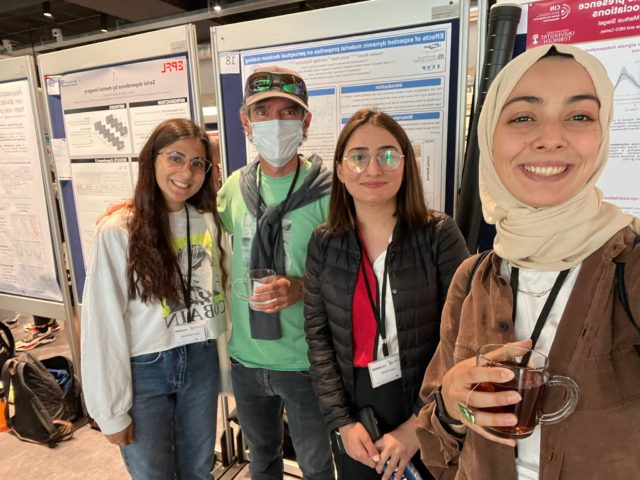
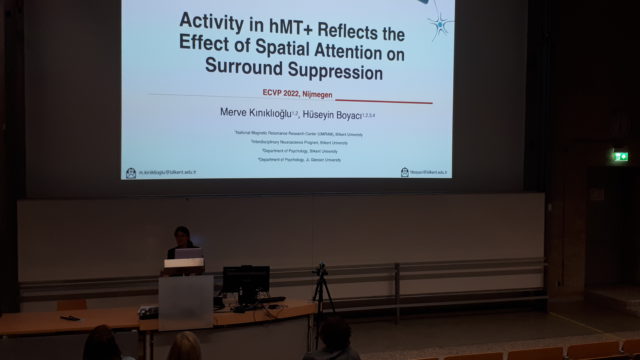
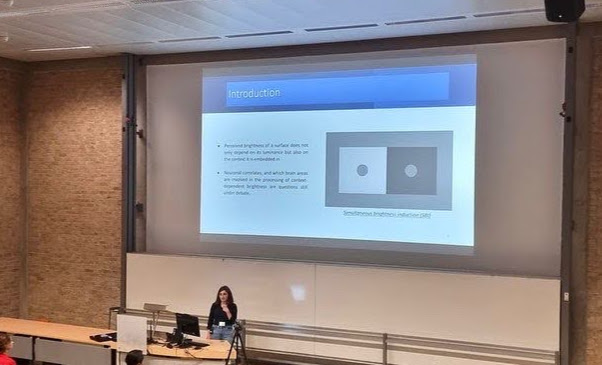
Liebig Professorship at Giessen University
Huseyin Boyaci was awarded the Liebig Computational Cognitive Neuroscience Professorship at the Psychology Department, Giessen University. The position is at a 25% capacity and includes a research budget that we plan to spend partly on supporting our Bilkent students to visit Giessen University during the summer. One of our students just completed a 3-month-long visit within that scope.
A New Project in Germany
A new project titled “Cardinal mechanisms of perception: Prediction, Valuation, Categorization,” funded by the Deutsche Forschungsgemeinschaft (DFG, German Research Foundation), has been started. Katja Doerschner and Huseyin Boyaci lead the sub-project “Integration of prior knowledge and sensory information in the perception of material qualities.”
Two Preprints
We have two new preprints:
The first one is by Gurbuz, T, Boyaci, H, and titled “Tilt aftereffect spreads across the visual field.” bioRxiv, https://doi.org/10.1101/2022.06.21.496978
The second one is by Malik, A, Doerschner, K, Boyaci, H, and titled “Unmet Expectations About Material Properties Delay Perceptual Decisions.” bioRxiv, https://www.biorxiv.org/content/10.1101/2022.07.28.501825v1 (2.8.2022)
News from Alumni: Dr. Zahide Pamir Receives TUBİTAK Award
Dr. Pamir received her PhD degree in 2017 as the first student to do so in our group and the Neuroscience graduate program. After that, she conducted postdoctoral research at Harvard University. Now she is returning to Turkey supported by TUBİTAK’s 2232B program. Congratulations Zahide! News link: https://www.tubitak.gov.tr/tr/haber/tubitakin-beyin-gocunu-tersine-ceviren-programlari-ile-63-arastirmaci-daha-ulkemize-geliyor. (21.5.2022)
News from Alumni: Dr. Buse Ürgen Starts Teaching at TED University
Dr. Ürgen received her Ph.D. degree in 2021 and continued working at CBVG as a postdoctoral fellow until this year. Now she is starting her academic career at TED University. Congratulations Buse! (21.5.2022)
Article in Press
Merve Kınıklıoğlu’s article “Increasing the Spatial Extent of Attention Strengthens Surround Suppression” is in press in Vision Research. Congratulations Merve! (bioRxiv preprint link.) (21.5.2022)
Update: The article is published and can be found at https://doi.org/10.1016/j.visres.2022.108074
New STAR Members
Büşra Ayar and Ecenur Bilgiç have received a STAR fellowship from TUBITAK. They will work as research assistants in the project “Neuronal Basis of Perceptual Learning” supported by TUBITAK. Congratulations Büşra and Ecenur! (7.2.2022)
New Preprint
Kiniklioglu, Boyaci, Increasing spatial extent of attention strengthens surround suppression
Visual sensitivity to a stimulus can be modulated (suppressed or facilitated) by other stimuli presented in its surround. But how the extent of spatial attention affects this ‘center-surround’ interaction in motion perception in humans has not been systematically studied before. Here we show that wider spatial attention leads to stronger surround suppression in a motion direction discrimination task. Furthermore, through computer simulations, we show that the activity patterns of middle temporal cortex neurons might give rise to this effect. Finally, we argue that abnormal attention mechanisms may lead to abnormal surround suppression observed in some clinical populations.
Graduate School Open House
Bilkent Univesity Graduate School of Science & Engineering is organizing a virtual open house on the 27th of March (2021). The Neuroscience Program will be there. For more details, see http://gradopenhouse.bilkent.edu.tr/
New Preprint
Urgen, Boyaci, A recurrent cortical model can parsimoniously explain the effect of expectations on sensory processes

The manuscript shows that a simple and parsimonious cortical model can explain the behavioral effects of prediction. The model does not require separate “error” and “representation” units as posited by leading models of predictive processes in the brain. The model also provides a unifying framework for behavioral and neuronal data.
New Projects
We have a new project supported by TUBITAK. The project is titled “Center-surround interaction in motion perception”. In this project, we will investigate the details of center-surround interaction in motion perception, including the role of spatial attention.
In another project led by Ozgur Mustecaplioglu (principal investigator) from Koc University, we will collaborate on quantum metrology using the human eye. The project is titled “Applications of Quantum Metrology with Human Eye”, and is supported by TUBITAK.
New STAR Member
Asli Tekin, an undergraduate research assistant in CBVG, received a STAR fellowship from TUBITAK. She will work on the “Neuronal Basis of Perceptual Learning” project supported by TUBITAK. Congratulations Asli!
Buse Merve Ürgen successfully defended her Ph.D. thesis!
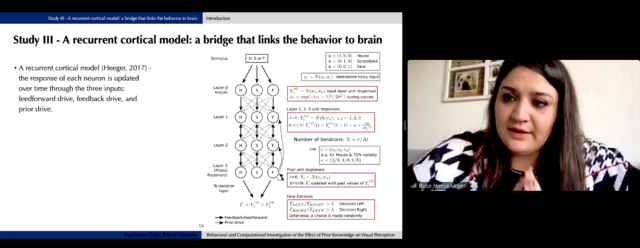
Buse defended her thesis, “Behavioral and Computational Investigation of the Effect of Prior Knowledge on Visual Perception,” on January 14, 2021. Please follow this link to see the abstract. We wish her the best of luck in her career!
New Publication
Schmid, Boyaci, & Doerschner, “Dynamic dot displays reveal material motion network in the human brain”
Using dynamic dot displays, we show that a large network of brain regions responds to material motion. The dynamic dot displays are similar to those in biological motion studies, and they allow researchers to isolate motion cues from all other cues to material properties (e.g., surface reflectance). Interestingly, the areas that are found to respond to material motion in this study constitute a superset of those found to respond to biological motion in previous studies.
New Publication
Urgen, Boyaci, “Unmet expectations delay sensory processes“
Prior knowledge and expectations play a substantial role in the recognition and decision-making processes by governing the interpretation of the sensory stimulus and allowing us to make fast and accurate decisions. Whether and how early sensory processes are affected by expectations, however, has remained a controversial issue. Using a behavioral experiment and a recursive Bayesian model, Urgen & Boyaci (2021) investigated the effect of expectations on perceptual thresholds and unveiled the possible mechanisms that underlie the observed effects. Specifically, they showed that unlike what is suggested for higher-level mechanisms, valid expectations do not facilitate perceptual processes, instead, unmet expectations delay them. Their modeling findings revealed that the mechanism that underlies this delay is the need for further processing required by the system to complete the sensory process. Urgen & Boyaci (2021) also discussed possible neural mechanisms that can explain their findings within the predictive processing framework.
Dilara Erişen successfully defended her Master’s thesis!
Dilara defended her thesis, “Investigating the effects of perceptual learning on the function and microstructure of the visual cortex,” on December 3, 2020. We wish her the best of luck with her PhD!
New Publication
Altan, Boyaci, “Size aftereffect is non-local”
Prolonged exposure to a certain size stimulus alters the perceived size of a subsequently presented stimulus at the same location. How the rest of the visual space is affected by this size adaptation, however, has not been systematically studied before. In this study, we tested size adaptation at the adapter location as well as the rest of the visual space. Our results showed that the perceived sizes of target stimuli were affected by the adapter, not only at the adapter location but also at other locations. These findings demonstrate that size adaptation causes widespread distortion of the visual space and alters perceived size. We discuss possible computational models that may underpin the perceptual effect in the article.
New Publication
Er, Pamir, Boyaci, “Distinct patterns of surround modulation in V1 and hMT+”, https://doi.org/10.1016/j.neuroimage.2020.117084
Using fMRI and a well-studied motion paradigm, in which sensitivity to the direction of motion increases (decreases) for a low (high) contrast stimulus as its size gets bigger, Er et al. show that patterns of center-surround interaction are different in primary visual cortex (V1) and middle temporal complex (hMT+). Furthermore, we show that the divisive normalization model can successfully predict the responses in V1 and hMT+ and link the behavioral and fMRI data.
Recent preprints from CBVG!
CBVG has recently shared four preprints:
- Distinct patterns of surround modulation in V1 and hMT+
- Dynamic dot displays reveal material motion network in the human brain
- Assessing Topographic Structural Connectivity of the Human Basal Ganglia and Thalamus
- Size Aftereffect is non-local
Beyza Akkoyunlu successfully defended her Master’s thesis!
Beyza defended her thesis entitled “Functional changes in the human cortex over the course of visual perceptual learning” on March 20, 2020, at Aysel Sabuncu Brain Research Center. Please follow this link to see the abstract. We wish her good luck in her career!
Seminar: “Oscillatory Recurrent Gated Neural Integrator Circuits (ORGaNICs): A Unifying Theoretical Framework for Neural Dynamics” by David Heeger @ Bilkent!
Prof. Heeger recently gave a talk entitled “Oscillatory Recurrent Gated Neural Integrator Circuits (ORGaNICs): A Unifying Theoretical Framework for Neural Dynamics” at Bilkent as part of the Neuroscience Seminar Series Fall 2019. Later, he gave another talk on his recent model at the Dynamics in Vision and Touch (DyViTo) workshop in Cappadocia, Turkey.
Please click here to see the talk announcement.
Six Master’s theses defended successfully!
Batuhan Erkat: Mapping Human Visual Cortex With Population Receptive Field Model: Tuning FMRI and Stimulus Parameters, and Exploring Receptive Field Sizes
Cemre Yilmaz: Effect of Visual Stimuli With Fearful Emotional Cue on Population Receptive Field Estimates
Ecem Altan: The Spatial Extent of Size Adaptation Effect in Peripheral Vision
Ilayda Nazli: The Effect of Orientation-Related Prior Probability Information on Contrast Perception
Cem Benar: Temporal and Spatial Nonlinearities in fMRI BOLD Response in Human Primary Visual Cortex
Hossein Mehrzadfar: Comparing the Performance of Humans and 3D-Convolutional Neural Networks in Material Perception Using Dynamic Cues
Congratulations Cemre, Batuhan, Ecem, Ilayda, Cem and Hossein for the fantastic job!
Save the dates! Six Master’s thesis dissertations in the first week of July, 2019
July 1: Cemre Yilmaz, Batuhan Erkat, Ecem Altan
July 2: Ilayda Nazli
July 4: Cem Benar, Hossein Mehrzadfar
Görkem Er successfully defended his Master’s thesis!
Gorkem defended his thesis entitled “The Role of Contrast and Size in Motion Perception: Behavioral and Neuroimaging Study of Center-Surround Interactions in Primary Visual Cortex (V1) and Middle Temporal Area (MT+) ” on September 13, 2018 at Aysel Sabuncu Brain Research Center. Please follow this link to see the abstract. We wish him good luck in his career!
Zahide Pamir successfully defended her PhD thesis!

Zahide defended her PhD thesis entitled “The Effect of Context-dependent Lightness on Contrast Detection and Identification, and Its Neural Correlates” on 19 October 2017 at Aysel Sabuncu Brain Research Center. Please click here for the abstract. We wish her all the best and success in her future career!
CBVG was at ECVP 2017!
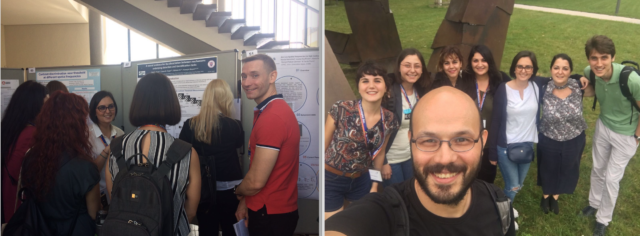
We, as CBVG, presented our work at ECVP 2017, Berlin. Please visit http://vision.bilkent.edu.tr/publications/ for more information about our abstracts.

